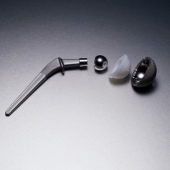
TUESDAY, March 13 (HealthDay News) — There is “unequivocal evidence” that stemmed metal-on-metal hip replacements fail at much higher rates than other types of hip implants and should therefore be banned, researchers say.
The failure rate is particularly high for stemmed metal-on-metal (MOM) hip implants with larger head sizes and those implanted in women. In these cases, failure rates are up to four times higher than other types of hip implants, according to the study in The Lancet.
U.K. researchers analyzed data on more than 400,000 hip replacements (including over 31,000 MOM implants) performed between 2003 and 2011. The patients in the National Joint Registry of England and Wales were followed for up to seven years after surgery.
Stemmed MOM implants had a five-year failure rate of 6.2 percent, which was much higher than implants made from ceramic and polythene. Failure was related to head size. Each 1 millimeter increase in head size was associated with a 2 percent increased risk of failure.
The failure rate for ceramic-on-ceramic implants actually improved with larger head sizes.
In women, failure rates for stemmed MOM implants were up to four times higher compared to ceramic or polythene implants.
“Metal-on-metal stemmed articulations give poor implant survival compared with other options and should not be implanted,” concluded professor Ashley Blom, from the University of Bristol in the United Kingdom, and colleagues. “All patients with these bearings should be carefully monitored, particularly young women implanted with large diameter heads.”
The study’s publication comes 10 days after the Medicines and Healthcare products Regulatory Agency in the United Kingdom announced that patients with stemmed MOM hip replacements require annual check-ups.
The use of stemmed MOM hip implants has declined in the United Kingdom, but they are still used extensively in the United States, accounting for 35 percent of hip replacements in 2009. Large-head stemmed MOM implants became popular because it was believed that they reduced the risk of dislocation and were highly resistant to wear.
The situation involving stemmed MOM hip implants highlights the need for careful evaluation of the safety and effectiveness of medical devices before they’re approved by U.S. regulators, Dr. Art Sedrakyan, of Cornell University’s Weill Cornell Medical College in New York City, said in an accompanying editorial.
“The [U.S.] National Institutes of Health is interested in new discoveries and, until recently, not in infrastructure for comparative safety and effectiveness,” Sedrakyan wrote. “There is also substantial pressure from Congress not to stifle innovation and to undertake faster reviews…. [These practices] fail to recognize that only a large national, or even worldwide, registry can address the needs when more than 10,000 products are on the market for the same purpose.”
Sedrakyan urged policy makers to require long-term testing of implants, as some product malfunctions can take years to develop.
“In the case of the ASR and metal-on-metal implants, it took 45 years before evidence was accumulated and reported,” he wrote. “We are left with more than 500,000 patients with metal-on-metal prostheses in the United States and more than 40,000 in the United Kingdom who are at elevated risk of device failure, which will inevitably result in the burden of further surgical treatment as well as billions of dollars in costs to taxpayers.”
The ASR Hip System was recalled in August 2010, according to the manufacturer’s website, DePuy Orthopaedics.
More information
The U.S. National Institute of Arthritis and Musculoskeletal and Skin Diseases has more about hip replacement.

